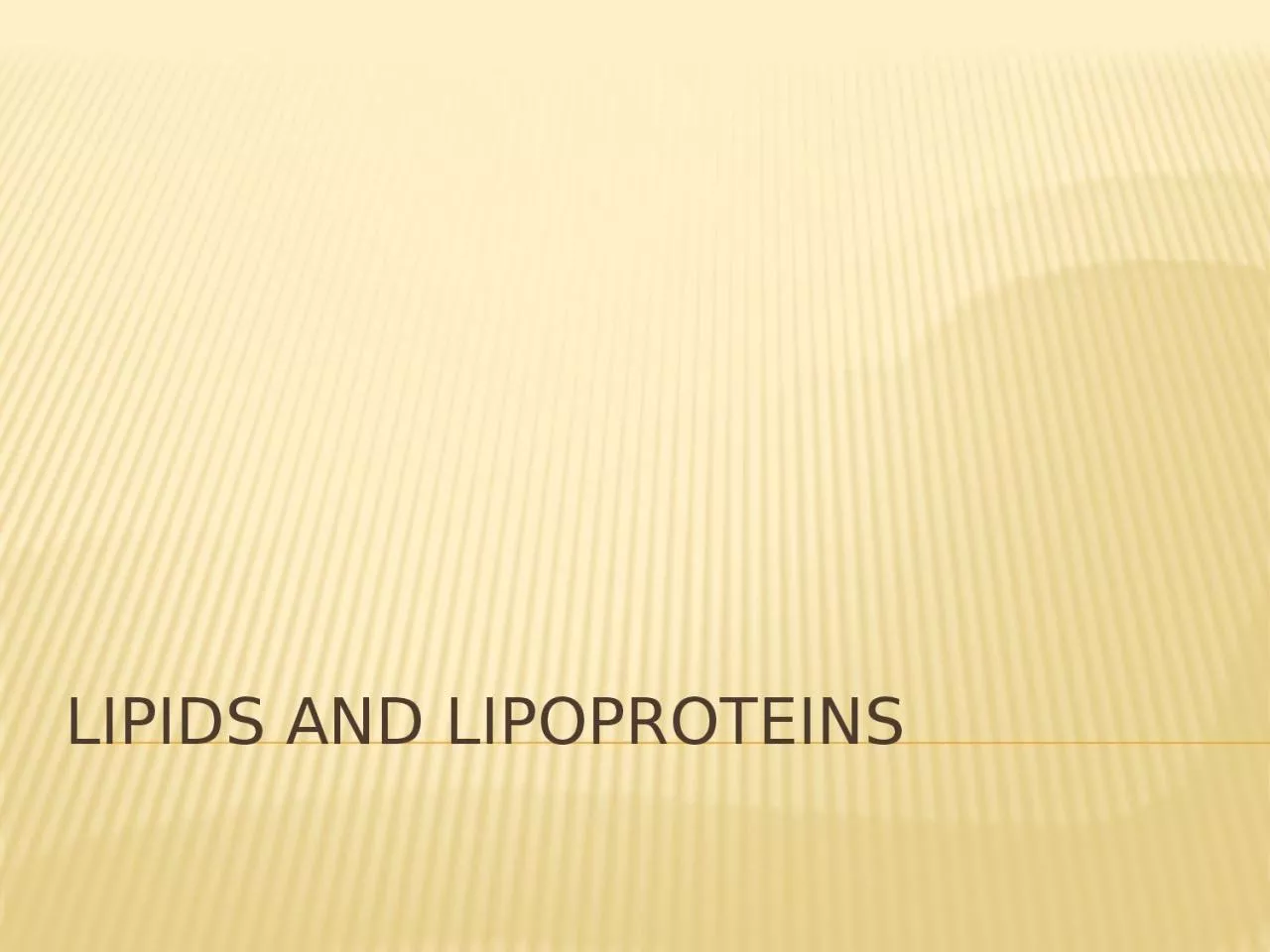

Main lipids in the blood are the triglycerides and cholesterol Insoluble in the water Transport in the blood is via lipoproteins Triglycerides Glycerol with 3 attached fatty acids Exogenous source Dietary ID: 1045207
Download Presentation The PPT/PDF document "Lipids and lipoproteins Lipid chemistry ..." is the property of its rightful owner. Permission is granted to download and print the materials on this web site for personal, non-commercial use only, and to display it on your personal computer provided you do not modify the materials and that you retain all copyright notices contained in the materials. By downloading content from our website, you accept the terms of this agreement.
1. Lipids and lipoproteins
2. Lipid chemistry and cardiovascular profileMain lipids in the blood are the triglycerides and cholesterol.Insoluble in the water.Transport in the blood is via lipoproteins
3. TriglyceridesGlycerol with 3 attached fatty acidsExogenous source : DietaryEndogenous : Liver and tissue storage95 % of body fat is triglyceridesEnergy source when plasma glucose is decreasedTriglyceride catabolism is regulated by lipase, epinephrine and cortisolTriglycerides transported by Chylomicrons ( exogeneous ) and VLDL ( endogenous )
4. CholesterolFound only in animalsImportant component of membranes, steroid hormones, bile and Vitamin DExogeneous cholesterol comes from dietEndogeneous cholesterol is synthesized by the liver70 % of cholesterol associated with cellular components30 % is in the plasma ( ⅓ free form , ⅔ esterfied ) Transported by HDL and LDL4
5. Fatty acids are short to long carbon chained moleculesSaturated fatty acidsUnsaturated fatty acidsPhospholipidsImportant components of cell membranesLecithin and sphingomyelin are utilized to determine fetal lung maturity from amniotic fluid ( L / S Ratio )GlycolipidsLipids with a carbohydrate componentABO antigen are glycolipids
6. lipoproteinsLipoprotein is a complex spherical structure that has a hydrophobic core wrapped in hydrophilic coating.4 major classes of lipoproteins.ChylomicronsVery low density lipoproteins (VLDL)Low density lipoproteins (LDL)High density lipoproteins (HDL)
7. Lipoproteins compositions
8. Composition of lipoproteinsClassDiameter (nm) % protein % cholesterol % phospholipid % triacylglycerol& cholesterol esterHDL5–153330294LDL18–282550218IDL25–5018292231VLDL30–8010221850Chylomicrons100-1000<28784
9. Chylomicron structure
10. LDL Most core lipid in LDL is cholesterol ester. ApoB100 is only apolipoprotein in the surface.
11. LDL receptorAlso named as apoB-100/apoE receptorsLDL receptors exist in the liver and in most peripheral tissuesThe complexes of LDL and receptor are taken into the cells by endocytosis, where LDL is degraded but the receptors are recycledNumber and function of the receptor shows LDL levels.LDL cholesterol levels are positively related to risk of cardiovascular diseaseTherefore, cholesterol in LDL has been called “bad cholesterol”
12. ApoliproproteinsOuter protein “shell” of the lipoprotein moleculeThe protein – lipid interaction allows the water insoluble lipid to become soluble in plasma12
13. Classes of apolipoproteinsA, B, C, D, E are major classesSubclasses: apo A-1, apo C-IIN.B. function of all apolipoproteins are not yet knownAct as structural components of lipoproteins Recognize the lipoprotein receptors on cell membrane surface as ligand Activate/inhibit enzymes involved in lipoprotein metabolism
14. METABOLISM Exogenous Endogenous Lipoprotein lipase release FFA and glycerol from chylomicron and VLDLLecithin Cholesterol acyl transferase LCATForms cholesteryl esters from free cholesterol and fatty acids
15.
16.
17. Lipid and Lipoprotein Population DistributionsSerum lipoprotein concentrations differ between adult men and women, Primarily as a result of differences in sex hormone levels,Women having, on average, higher HDL cholesterol levels and lower total cholesterol and triglyceride levels than men. The difference in total cholesterol, however, disappears after menopause as estrogen decreases
18. HypercholesterolemiaFamilial hypercholesterolemia (FH) (7.5- 12 mmol/L)Primarily LDL elevationsSynthesis may be normal but decrease or lack LDL receptors due to mutation in LDL receptor gene.Therefore LDL builds-up in serumSince cells cannot acquire from LDL therefore increase internal synthesis of cholesterol.Tendon xanthomatasEarly occurrence of coronary artery disease M. Zaharna Clin. Chem. 200918
19. HypertriglyceridemiaTriglyceridesBorderline = 150-200 mg/ dlHigh 200-500 mg/dlVery High > 500 mg/dlFamilial hypertriglyceridemia Genetic Secondary hypertriglyceridemia Hormonal imbalances Imbalance between synthesis and clearance of VLDLM. Zaharna Clin. Chem. 200919
20. HypertriglyceridemiaGenerally caused by deficiency of LPL or LPL cofactor. (LPL hydrolyzes triglycerides in chylomicrons and VLDL)Deficiency prevents processing and clearing of triglyceridesElevated even with fastingM. Zaharna Clin. Chem. 200920
21. Familial Combined HyperlipidemiaPresence of elevated levels of serum total cholesterol and triglyceridesHepatic overproduction of apo BIncreased VLDL and LDLM. Zaharna Clin. Chem. 200921
22. Familial hyperchylomicronemiaGenetic mutation of LPL or apo C-II geneRecurrent abdominal painPancreatitis
23. Clinical disorders of lipid metabolismPrimary Secondary
24. hyperlipidemias
25.
26. secondaryDisease Lipid abnormalityDMTGAlcoholTGCRFTGDrugs thiazideTGHypothyroidismCholesterolNephrotic syndromeCholesterol